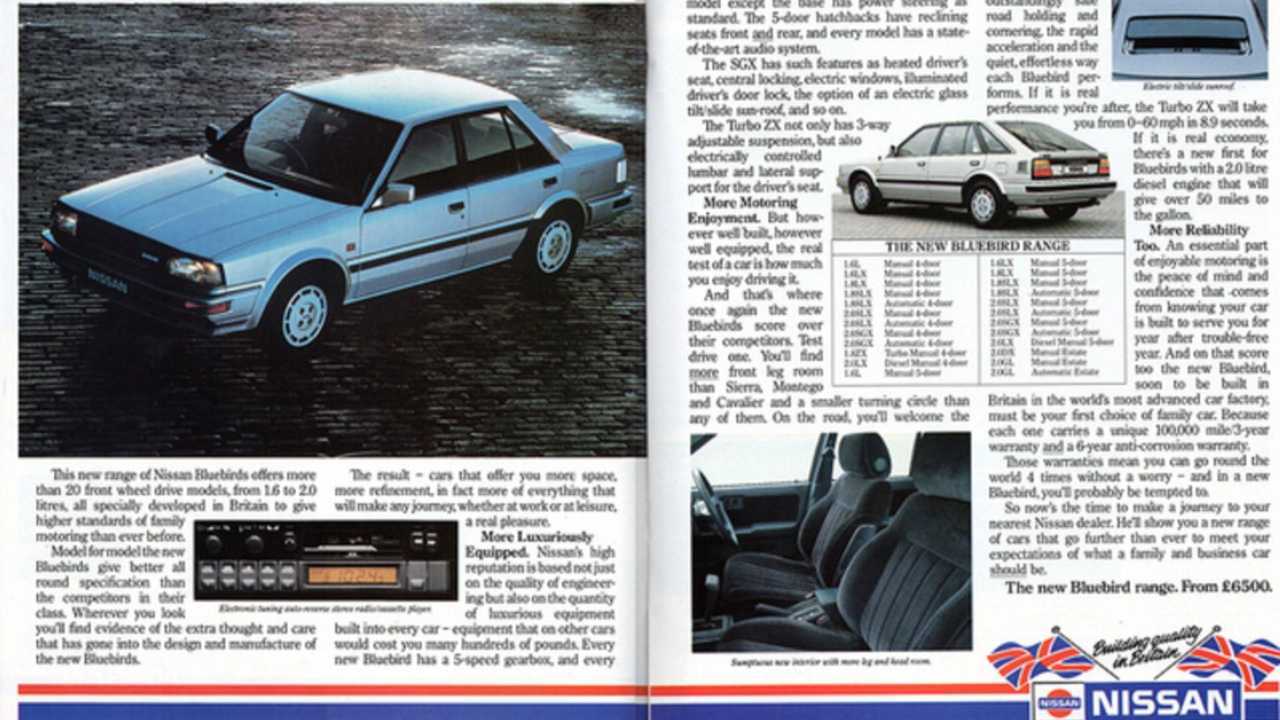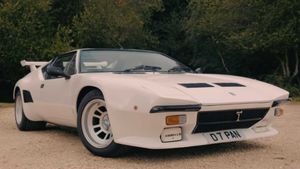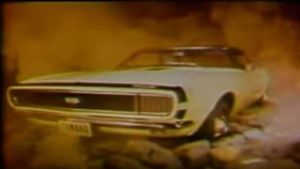With Brexit uncertainty hitting the UK's automotive sector, we take a look back at how a previous prime minster first got Japanese car makers investing in Britain
Nissan’s recent decision to manufacture the X-Trail SUV in Japan rather than the UK – further straining British industry during a time of Brexit revolt – has prompted accusations from many towards the Conservative party. Witnesses and investors claim that the current ruling government are undermining the British automotive industry.
However, while it remains difficult to look beyond the well-vexed infighting that currently dominates Westminster, it's easy to forget that the Conservatives brought significant automotive investment to Britain in the first place. Turning the clock back to the 1980s, it was former Conservative prime minister Margaret Thatcher who paved the way for Nissan's Sunderland plant to open.

Innovators, and those who boast of forward thinking, are often lavishly praised within the vehicular industry. But what about politicians? Chances are you won’t find many people expressing their gratitude towards an enterprising member of Parliament within classic car circles.
From negotiating harmonious international relations to encouraging multinational corporations to invest, from sourcing a suitable workforce to establishing the most advantageous geographical location; a politician can make or break the manufacturing industry, let alone provide a ripple effect that stretches outward on a global basis.
When you take into consideration how many political hoops any given car manufacturer has to jump through in-order to be successful on a worldwide level, politicians are surprisingly important.

Last month, Nissan announced a retraction upon their decision (initially stated in October 2016) to manufacture the X-Trail SUV from their UK Sunderland plant. This, alongside temporary shutdowns at BMW’s Oxford Mini factory and the Goodwood Rolls-Royce factory – not to mention 4500 up-coming job cuts at Jaguar Land Rover – has prompted journalistic accusations towards the Conservative government of senselessly damaging the British car-making industry. With Brexit looming on 29 March 2019, it seems too late to reverse such business decisions.
However, Nissan’s decision to manufacture the X-Trail in Japan does not entirely result from Brexit, but perhaps instead from common business sense. Uncertainty as to whether there will be a 'no-deal Brexit' certainly contributes, yet the decision has also stemmed from tightened European diesel emission regulations and a new EU-Japan free trade agreement. Implemented a few weeks ago, the new agreement removes tariffs of 10% on imported Japanese cars.

Nissan has stated their intention to continue manufacturing the current Qashqai, Leaf and Juke models at the Sunderland plant (for now) and that job losses will be minimal. From 2020, Nissan plan to manufacture the succeeding edition of the Qashqai – a model that has been so heavily in demand that the Sunderland plant had to introduce a night shift to keep up.
As the Qashqai has proven popular enough to find footing in Japan, and therefore enjoy export success back to Nissan's home country, the consequent successor could prove to be the UK's new automotive backbone. Producing some 2000 cars a day, the Sunderland plant remains Britain’s biggest car factory, and such statement may remain.
However, it was largely thanks to the efforts of former Conservative prime minister Margaret Thatcher that such prosperity for Sunderland materialized.

When Thatcher came to power in 1979, the British car industry was in tatters. Vehicles leaving various British Leyland factories were not competitive and often faulty. Production processes were inefficient, workforce morale was at an all-time low and endless industrial disputes gained regular headlines. Something had to be done. Through the well-documented throng of protesting workers and burning braziers, in stepped Thatcher – handbag and pearls firmly in place.
Margaret was a long-term thinker. She was interested in tackling current day problems, but with strategies that would stand the test of time. Aware that British Leyland was on a severe spiral of decline – while absorbing significant government investment just to survive – Thatcher encouraged automotive manufacturers from other shores to consider the UK as an ideal manufacturing gateway.

Not only could Thatcher see that the UK had excellent potential to act as an access point to the European market but also, due to the reduction of the heavy industries in her own country, she had many unemployed Brits seeking work. Despite the majority of UK coalmines having closed under a Labour government during the 1970s, Thatcher had endured much scapegoating for the resultant decline in available work. This was surely a chance to simultaneously remedy the problem and silence the critics.
To attract successful manufacturers from abroad was a perfectly logical step to Thatcher for addressing the problem. She was keenly aware that the unemployment rate in the North-East of England was higher than the UK average and, while discussing the issue in a TV interview with Tyne Tees she said: “Our approach is a very positive one. We try to get more business here.”

The idea was a good one, but Thatcher was to face hurdles from every angle, both at home and abroad. Several British car manufacturers were not impressed that Thatcher wanted to attract business from ‘the competition’ abroad. Her former private secretary, Lord Butler, believes that Thatcher hoped it would bolster the UK automotive industry.
“She was in favour of was competition, geeing them up, stimulating them, and that was a lot of the motive for having Nissan in. If they couldn't compete, she thought they shouldn't survive." (Lord Robin Butler)

Meanwhile, the unions pointed out that the Japanese would likely bring no strike agreements with them. There were mutterings from the public about resentment that still lingered from World War II. Such disgruntlement went on, and this was before she had become prime minister.
While serving as Leader of the Opposition, Thatcher had started to lobby Japanese prime minister Yasuhiro Nakasone, and Japanese industries, to establish UK bases. Initially Japan wasn’t convinced, but Margaret was resolute in persuading those she was writing to that doing business with Britain could benefit them as well as the UK enormously.

In 1977, she visited one of Nissan’s automated plants and was informed that Katsuji Kawamata, the aging chairman of the company, believed Nissan should slow production down in-order to expand the business. She explained how the UK’s membership of the European Union could help Nissan expand by boosting sales rather than reduce them. There was a glimmer of hope, for Mr Kawamata agreed to an on-going correspondence with Thatcher on the matter.
In 1980, Trade Minister Keith Joseph wrote to Margaret stating that the UK’s membership of the European Community was likely to be critical to Japan agreeing a deal.

‘The deal is tangible evidence of the benefits to the UK of membership of the European Community; Nissan has chosen the United Kingdom because it gives them access to the whole European market. If we were outside the community, it is very unlikely that Nissan would have given the United Kingdom serious consideration as a base for this substantial investment.’ (Trade Minister Keith Joseph)
In 1981, two years after becoming prime minister, the seeds sown by Margaret through her visit to Nissan in 1977 (and subsequent letters) yielded a promising result - Nissan were interested in establishing a manufacturing base within Europe. They hadn’t yet confirmed the UK as their chosen base, but it was a start.

Margaret sensed a window of opportunity and, the following year, she met with executives in Japan to discuss proposals. She also personally visited Mr Kawamata to put a case forward for Britain. Ironically, the biggest obstacles lay back at home.
In the run-up to the 1984 budget, cabinet rifts were threatening the project. Chancellor Nigel Lawson was pushing for the abolition of capital allowances, which allowed the tax-free purchase of industrial machinery. Without capital allowances, the UK start-up costs would cost Nissan around £27.5m in the first year.

This was risky from Thatcher’s perspective, as she’d put forward capital allowances as one of the main attractions for Nissan setting up business in the UK and, in return, Margaret had received a pledge for inward investment from Nissan.
Lawson’s radical tax reforms of 1984 could have been a major deal-breaker. It would have taken Nissan years to recoup their investment if they’d went ahead in the circumstances. With the help of Trade and Industry Secretary Norman Tebbitt, Thatcher was able to negotiate a special deal for Nissan. Many letters and telegrams were exchanged in finalizing the deal, while exact details of the financial arrangements were kept low key to avoid potentially upsetting other businesses.

Around the same time, three possible sites for the new Nissan plant had been assessed in Sunderland, Immingham and Shotton. Thanks to recent industrial decline in the area – as well as its close proximity to the Tynes and Tees ports and Newcastle International Airport – a 799-acre site in Sunderland was chosen. Once the grounds of the RAF Usworth aerodrome, news of what the disused space would become created a rush of optimism amongst the local workforce. The factory couldn’t come any quicker.
On September 8th 1986, Margaret Thatcher and Nissan’s President Yutaka Kume completed the official opening of the all-new Nissan plant. Accompanied by husband Denis, Margaret met with staff and was photographed signing the visitor’s book. In her opening speech she said:

“It was in 1984 that we heard of Nissan's decision to establish a pilot assembly plant in Britain and we so very warmly welcomed their decision. It was confirmation from Nissan after a long and thorough appraisal, that within the whole of Europe, the United Kingdom was the most attractive country—politically and economically—for large-scale investment and offered the greatest potential.
'That was good news and of course we thought the decision absolutely right. It was a compliment in particular to those who had advocated the benefits of the North East, whose infrastructure, traditions and people offer such a promising environment for substantial new manufacturing exercise.”

Prior to Margaret’s speech, Nissan’s UK production had already commenced with a white T12-series Bluebird 2.0 GTX, registration JOB 1, being the first to leave the factory floor on July 8 1986. The plant initially employed 430 staff, manufacturing some 95 cars per day.
Exports began the following year while the Nissan plant and its workforce grew ever larger. A wave of foreign investment, including some 1000 other Japanese companies and car marques followed suit, establishing themselves in the UK. Toyota took root in Derby while Honda opted for Swindon.
Discussing the Sunderland plant’s success in a BBC Radio interview during 1987 Margaret said ‘I was absolutely thrilled. It has brought a new hope to them.’

Some thirty-three years later, Nissan's Sunderland factory has become the largest automotive plant on UK soil, now employing some 7000 people and producing 500,000 cars per year. A further 40,000 jobs are supported indirectly by the plant. Nissan has manufactured more than 6.2 million vehicles at Sunderland including the Bluebird, Primera, Micra, Almera, Note, Qashqai and Juke. Their first vehicle, the aforementioned JOB 1, resides in the Sunderland Museum & Winter Gardens as a mark of success for the region.
“Decades later, we continue to see the rewards of Thatcher, and her Conservative government’s, persistence in bringing Nissan to the region with hundreds of direct jobs and thousands more in the supply chain. To remain competitive and attract more of this kind of private sector investment today, we must get rid of some of the European red tape that holds us back. Mrs Thatcher recognised that and so must we. It’s been one of the outstanding success stories of the region. It was a very far-sighted decision of Mrs Thatcher.”(Conservative MP Martin Callanan)
'
For the time being, it looks like Nissan are prepared to ride the wave of uncertainty that the Brexit proceedings bring with them, while many major UK marques have already begun to set up elsewhere. Hopefully, with Nissan’s commitment to maintain production, the UK will continue to benefit from Thatcher’s long-term insight.
“A characteristic of our age is the extent to which we are increasingly one world in which the significance of distance is very greatly reduced and in which we are more dependent than ever before on each other. No country can any longer, in a serious sense, go it alone.” (Margaret Thatcher)
Whether Margaret Thatcher would have known it or not, sitting behind the wheel of a Nissan Bluebird for press photos on the official opening day, the Nissan Sunderland plant was one of her greatest achievements when it came to British industry.
Image sources: Nissan Media UK, Shutterstock, Getty Images
Information sources: The Journal, The Margaret Thatcher Centre, Nissan UK, Margaret Thatcher Foundation




